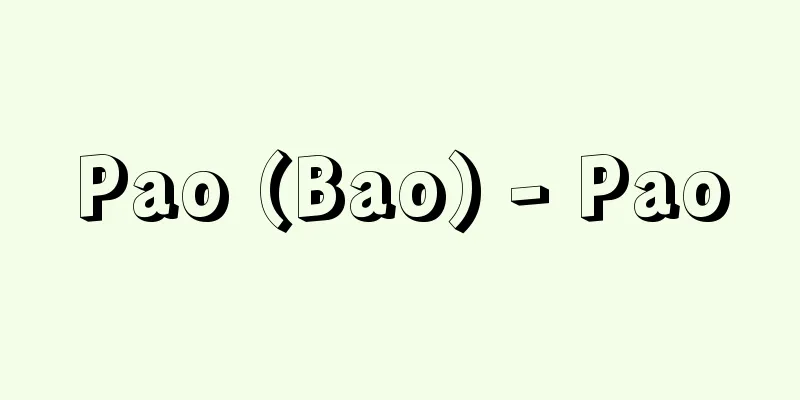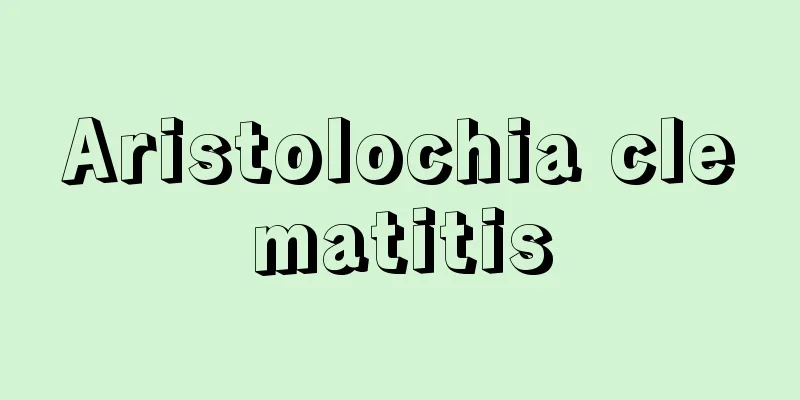Swine cholera - classical swine fever

|
An infectious disease of pigs and wild boars caused by the hog cholera virus. It cannot be transmitted to humans, and is not related to human cholera caused by the cholera bacterium Vibrio cholera. Pork infected with hog cholera is not sold on the market, but even if you eat the meat or innards of a pig infected with hog cholera, it will not affect your health. Experimentally, it is known that animals such as mice, guinea pigs, rabbits, goats, and sheep can be temporarily infected with the hog cholera virus, but they do not become ill. Hog cholera is highly contagious and deadly to pigs and wild boars, and is designated as a legally-determined infectious disease for livestock. Pigs infected with the hog cholera virus begin with symptoms such as fever, loss of appetite, lethargy, and hunching over, and then show a variety of other symptoms, including constipation followed by diarrhea, conjunctivitis, swollen lymph nodes, respiratory problems, tremors, and difficulty standing up. In the case of acute hog cholera, death generally occurs within 10 to 20 days after onset. On the other hand, if the disease repeats onset and recovery, and then the patient dies within about 30 days, it is called chronic hog cholera. Whether the disease becomes acute or chronic depends not only on the virus strain, but also on factors related to the pig, such as age, breed, and immune status. The hog cholera virus is present in the saliva, nasal mucus, and feces of infected pigs and wild boars, and the infection spreads through these. The virus is also found in the blood, muscles, and internal organs of diseased pigs. Therefore, it is known that the infection can also spread through meat and processed products from diseased pigs and wild boars. In Japan, hog cholera used to be rampant throughout the country. However, thanks to improvements in animal husbandry hygiene management techniques and the development and widespread use of a live vaccine in Japan, there have been no confirmed cases of the disease in Japan since 1992. In April 2006, the use of the vaccine was completely discontinued. In April of the following year, Japan became a hog cholera-free country as stipulated by the regulations of the World Organization for Animal Health (OIE). In September 2018, an outbreak of hog cholera occurred on a farm in Gifu Prefecture for the first time in 26 years in Japan. The Ministry of Agriculture, Forestry and Fisheries took preventive measures such as culling and disinfection, but as of December 2019, the outbreak has not yet been contained. A vaccine that was initially not supposed to be used on farmed pigs has now begun to be administered, although in limited areas. Since the outbreak of swine cholera in Gifu Prefecture in 2019, outbreaks have also been confirmed at farms and related facilities in Aichi, Nagano, Shiga, Osaka, Mie, Fukui, Saitama, and Yamanashi prefectures. According to an epidemiological survey conducted by the Ministry of Agriculture, Forestry and Fisheries, the virus isolated in the domestic case was presumed to have been introduced from China or a neighboring country. However, rather than the virus being introduced directly into the farm from overseas, it was more likely that the virus had entered a wild boar group from overseas and then spread to the pigs on the farm. As a result, the Ministry of Agriculture, Forestry and Fisheries has implemented measures to combat wild boars, including strict hygiene management, supporting the installation of protective fences, strengthening capture efforts, and distributing oral vaccines. On the other hand, regarding the prevention of hog cholera in farmed pigs, the "Guidelines for the Prevention of Specified Livestock Infectious Diseases Regarding Hog Cholera" stipulate early detection and the prompt culling of infected or suspected infected pigs as the principle, and stipulate not to administer preventive vaccinations. The reason for this is that while hog cholera vaccines can prevent the disease from developing if administered properly, unplanned and unregulated use of vaccines can make it difficult to detect the presence of infected pigs, making early detection difficult, and potentially hindering the prevention of the spread of the disease. However, in October 2019, the quarantine guidelines were revised to state that "areas with a high risk of swine cholera infection from wild boars infected with the swine cholera virus to pigs and other animals will be designated as areas where vaccination is recommended." Gunma, Saitama, Toyama, Ishikawa, Fukui, Nagano, Gifu, Aichi, Mie, and Shiga prefectures were designated as areas where vaccination is recommended, and vaccinations have begun one after another. Shipments of pigs vaccinated against swine cholera began in November, but the Ministry of Agriculture, Forestry and Fisheries has announced that "there have been no reports of any effects on human health from eating meat from vaccinated pigs." The Ministry of Agriculture, Forestry and Fisheries also changed the name of hog cholera to "CSF (Classical swine fever)". The current name "hog cholera" is reminiscent of cholera, a human epidemic, so the aim is to avoid causing unnecessary anxiety and distrust. For the same reason, "African swine fever" was also renamed to "ASF (African swine fever)". (Hoshino Miho, Freelance Writer/2019) Source : "Chiezo" published by Asahi Shimbun Publications Co., Ltd. About Chiezo |
|
豚コレラウイルスによる、豚とイノシシの感染症。人に感染することはない。また、コレラ菌が原因となる人のコレラとは関係はない。豚コレラに感染した豚肉が市場に出回ることはないが、仮に豚コレラに感染した豚の肉や内臓を食べても、人の健康に影響することはない。実験的には、マウス、モルモット、うさぎ、山羊、めん羊などの動物が一時的に豚コレラウイルスに感染することは知られているが、発病することはない。 豚コレラは、豚やイノシシに対する伝染力や致死性が高く、家畜の法定伝染病に指定されている。豚コレラウイルスに感染した豚は、発熱や食欲不振、元気がなくなる、うずくまるなどの症状から始まり、便秘に続く下痢、結膜炎、リンパ節の腫れ、呼吸障害、震え、起立困難などの多様な症状を示す。急性豚コレラの場合、一般的に発症から10~20日以内に死亡する。一方、発症回復を繰り返した後に30日程度で死亡するものを慢性豚コレラという。急性になるか慢性になるかは、ウイルスの株の違いだけでなく、月齢や品種、免疫状態など豚側の要因にも影響を受ける。 豚コレラウイルスは、感染した豚やイノシシの唾液(だえき)や鼻水、糞(ふん)に混じっているため、それらを介して感染が拡大する。また、ウイルスは発病した豚の血液や筋肉、内臓にも含まれる。そのため、発病した豚やイノシシの精肉やその加工品からも感染が広がることが知られている。 日本でも、かつては豚コレラが全国に蔓延(まんえん)していた。しかし、飼養衛生管理技術の向上や、日本で生ワクチンが開発され普及したことにより、1992年を最後に国内での発生は確認されなくなった。2006年4月からは、ワクチンの使用を完全に中止。翌年の4月に、日本は国際獣疫事務局(OIE)の規約に定められた、豚コレラ清浄国となった。 2018年9月、国内では26年ぶりに岐阜県の農場で豚コレラが発生した。農林水産省は殺処分、消毒などの防疫措置を講じたが、2019年12月現在、いまだ終息していない。当初、飼養豚には使用しないとしていたワクチンも地域限定だが接種が始まった。 岐阜県から発生した豚コレラは、19年に入り愛知県、長野県、滋賀県、大阪府、三重県、福井県、埼玉県、山梨県などの農場やその関連施設においても発生が確認された。 農水省が行った疫学調査によると、国内発生例で分離されたウイルスは中国または周辺国から侵入したウイルスと推定された。ただし、直接海外から農場にウイルスが入り込んだ可能性よりも、海外から野生イノシシ群にウイルスが侵入し、それが農場の豚に伝染した可能性のほうが高いとした。 そのため、農水省は野生イノシシ対策として、衛生管理の徹底、防護柵(さく)の設置支援、捕獲強化や経口ワクチンの散布を進めてきた。 一方、飼育豚の豚コレラの予防に関しては、「豚コレラに関する特定家畜伝染病防疫指針」において、早期発見と、感染もしくは感染が疑われる豚の迅速な殺処分が原則とされ、予防的なワクチン接種は行わないこととされていた。豚コレラワクチンは、適切に接種すれば発症を防御することができるが、無計画かつ無秩序なワクチンの使用は感染した豚の存在を分かりにくくし、早期発見を困難にし、発生拡大の防止に支障をきたす恐れがある、というのがその理由である。 しかし、19年10月、「豚コレラウイルスに感染した野生イノシシから豚等への豚コレラ感染のリスクが高い地域を、ワクチン接種推奨地域に設定する」と防疫指針を改訂。群馬県、埼玉県、富山県、石川県、福井県、長野県、岐阜県、愛知県、三重県、滋賀県がワクチン接種推奨地域として設定され、順次接種が始まった。 11月には豚コレラワクチンを接種した豚の出荷も始まったが、農水省は「ワクチンを接種した豚の肉を食べて、人の健康に影響があったという報告はない」と公表している。 また、農水省は、豚コレラの名称を「CSF(Classical swine fever)」に変更した。現在用いられている「豚コレラ」の名称が、ヒトの疫病であるコレラを想起させることから、不要な不安や不信を招かないようにすることを目的としている。同じ理由で、「アフリカ豚コレラ」も「ASF(African swine fever)」と名称変更した。 (星野美穂 フリーライター/2019年) 出典 (株)朝日新聞出版発行「知恵蔵」知恵蔵について 情報 |
>>: Tonkori - Pork (English spelling) tonkori
Recommend
Hino Arinori
1302‐63 (Kengen 1‐Shohei 18/Sadaharu 2) An aristoc...
Phoeniconaias minor
…They breed in the Andean lakes from Peru to sout...
Eurydikē (English spelling) Eurydike
…For this reason, when he participated in the Arg...
Xanthos, E.
...From the late 17th century, when the Ottoman E...
Truck farming
This type of agriculture is located far from marke...
Dutch lionhead - Dutch lionhead
A variety of goldfish belonging to the order Cypr...
Demon Fighter
〘Noun〙 A special type of to (corner joint) that is...
Portolano
…Nautical charts developed in Europe in the 13th ...
Industrial poisoning
Poisoning caused by chemical substances generated ...
Earrings - Ear decorations
An accessory worn by pinching the earlobe or by dr...
Official kitchen - Kanchuuke
…Under these conditions, the Benboho was establis...
Stamp Tax Revolt
...The Breton region was the latest to appoint lo...
Mission - Dendou (English spelling)
To spread religious teachings and "convey th...
Cavity - Kuudou
〘noun〙① A hole that has opened up in something and...
'aṣaba (English spelling)
...For more information on Muslims, please refer ...









